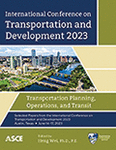Evaluation of Near-Miss Reporting Program Perceived by Employees’ Challenges and Opportunities
Publication: International Conference on Transportation and Development 2023
ABSTRACT
Eliminating job hazards and mitigating risks is a multilevel concern for organizations to help improve their safety performance. Organizations adopted several approaches to identify and eradicate job hazards by establishing health and safety management systems such as safety talks, near-miss reporting, and analysis of leading indicators. Near-miss incidents are considered a critical metric for health and safety management systems since they present an early indicator than an injury or incident waiting to occur. Several organizations struggle to promote this reporting and fail to collect enough reports necessary for data analysis to inform safety opportunities and consider corrective measures. The Kentucky Transportation Cabinet (KYTC) invested in a well-executed near-miss reporting program but is facing challenges in enhancing its practical use. As such, this research aims to investigate and document KYTC’s employees’ perceptions, concerns, and pain points that prevent them from widely using the program. Also, identify strategies that KYTC can readily adopt to increase the use of its existing near-miss program.
Get full access to this article
View all available purchase options and get full access to this chapter.
REFERENCES
Al-Shabbani, Z., A. Ammar, and G. Dadi. (2022). “Preventative Safety Metrics with Highway Maintenance Crews.” Proceedings of Construction Research Congress, ASCE, Arlington, Virginia, 510–519.
Al-Shabbani, Z., A. Ammar, H. Nassereddine, and G. B. Dadi. (2021). Development, Implementation, and Tracking of Preventative Safety Metrics. Kentucky Transportation Center, University of Kentucky.
Al-shabbani, Z., R. E. Sturgill Jr., and G. B. Dadi. (2017). Safety Concepts for Workers from an OSHA Perspective. Kentucky Transportation Center, University of Kentucky.
Ammar, A., Z. Al-Shabbani, and G. Dadi. (2022). “Assessing the Safety Climate of a State Department of Transportation through Its Highway Maintenance Crews.” Proceedings of Construction Research Congress, ASCE, Arlington, Virginia, 345–355.
Ammar, A., Z. Al-Shabbani, H. Nassereddine, C. Van Dyke, and G. B. Dadi. (2021). Evaluating the Safety Cultures of Kentucky Transportation Cabinet Maintenance Crews. Kentucky Transportation Center, University of Kentucky.
CII (Construction Industry Institute). (2014). Using Near Miss Reporting to Enhance Safety Performance (Best Practices). The University of Texas at Austin.
Dadi, G., A. Ammar, S. Atkins, and M. Horseman. (2022). Specialized Safety Training and Tracking for KYTC Construction and Maintenance Personnel. Kentucky Transportation Center, University of Kentucky.
Gnoni, M. G., and G. Lettera. (2012). “Near-miss management systems: A methodological comparison.” Journal of Loss Prevention in the Process Industries, 25 (3): 609–616.
Grabowski, M., P. Ayyalasomayajula, J. Merrick, and D. Mccafferty. (2007). “Accident precursors and safety nets: leading indicators of tanker operations safety.” Maritime Policy & Management, 34 (5): 405–425.
Gyi, D. E., A. G. F. Gibb, and R. A. Haslam. (2010). “The quality of accident and health data in the construction industry: interviews with senior managers.” Construction Management and Economics, 17 (2): 197–204.
Haas, E. J., B. Demich, and J. McGuire. (2020). “Learning from Workers’ Near-miss Reports to Improve Organizational Management.” Mining, Metallurgy & Exploration, 37 (3): 873–885.
Hinze, J., S. Thurman, and A. Wehle. (2013). “Leading indicators of construction safety performance.” Safety Science, 51 (1): 23–28.
NIOSH (National Institute for Occupational Safety and Health). (2022). “Highway work zone safety.”<https://www.cdc.gov/niosh/topics/highwayworkzones/default.html#:~:text=The%20Bureau%20of%20Labor%20Statistics,average%20of%20123%20per%20year > (October 31, 2022).
NSC (National Safety Council). (2013). “Near miss reporting systems.” <https://nsccdn.azureedge.net/nsc.org/media/site-media/docs/workplace/near-miss-reporting-systems.pdf?>(October 31, 2022).
NSC (National Safety Council). (2022). “Motor vehicle safety issues.” National Safety Council Injury Facts. <https://injuryfacts.nsc.org/motor-vehicle/motor-vehicle-safety-issues/work-zones/>(October 31, 2022).
OSHA (Occupational Safety and Health Administration). (2022a). “OSHA Injury and Illness Recordkeeping and Reporting Requirements.” <https://www.osha.gov/recordkeeping/>.
OSHA (Occupational Safety and Health Administration). (2022b). “Near-Miss Incident Report Form.” OSHA. <https://www.osha.gov/sites/default/files/2021-07/Template%20for%20Near%20Miss%20Report%20Form.pdf>(October 31, 2022).
Oswald, D., F. Sherratt, and S. Smith. (2018). “Problems with safety observation reporting: A construction industry case study.” Safety Science, 107: 35–45.
Phimister, J. R., U. Oktem, P. R. Kleindorfer, and H. Kunreuther. (2003). “Near-Miss Incident Management in the Chemical Process Industry.” Risk Analysis, 23 (3): 445–459.
Raviv, G., B. Fishbain, and A. Shapira. (2017). “Analyzing risk factors in crane-related near-miss and accident reports.” Safety Science, 91: 192–205.
van der Schaaf, T. W., D. A. Lucas, and A. R. Hale. (2013). Near Miss Reporting as a Safety Tool. Butterworth-Heinemann, Elsevier, Oxford, United Kingdom.
Tinsley, C. H., R. L. Dillon, and M. A. Cronin. (2012). “How Near-Miss Events Amplify or Attenuate Risky Decision Making.” Management Science, 58 (9): 1596–1613.
Williamsen, M. (2013). “Near-miss reporting: A missing link in safety culture.” Professional Safety, 58(05), 46–50.
Wright, L., and T. van der Schaaf. (2004). “Accident versus near miss causation: a critical review of the literature, an empirical test in the UK railway domain, and their implications for other sectors.” Journal of Hazardous Materials, 111 (1–3): 105–110.
Wu, W., A. G. F. Gibb, and Q. Li. (2010a). “Accident precursors and near misses on construction sites: An investigative tool to derive information from accident databases.” Safety Science, 48 (7): 845–858.
Wu, W., H. Yang, D. A. S. Chew, S. Yang, A. G. F. Gibb, and Q. Li. (2010b). “Towards an autonomous real-time tracking system of near-miss accidents on construction sites.” Automation in Construction, 19 (2): 134–141.
Yang, K., C. R. Ahn, M. C. Vuran, and S. S. Aria. (2016). “Semi-supervised near-miss fall detection for ironworkers with a wearable inertial measurement unit.” Automation in Construction, 68: 194–202.
Zhou, C., L. Ding, M. J. Skibniewski, H. Luo, and S. Jiang. (2017). “Characterizing time series of near-miss accidents in metro construction via complex network theory.” Safety Science, 98: 145–158.
Zhou, Z., C. Li, C. Mi, and L. Qian. (2019). “Exploring the Potential Use of Near-Miss Information to Improve Construction Safety Performance.” Sustainability, 11 (5): 1264.
Information & Authors
Information
Published In
History
Published online: Jun 13, 2023
ASCE Technical Topics:
Authors
Metrics & Citations
Metrics
Citations
Download citation
If you have the appropriate software installed, you can download article citation data to the citation manager of your choice. Simply select your manager software from the list below and click Download.
